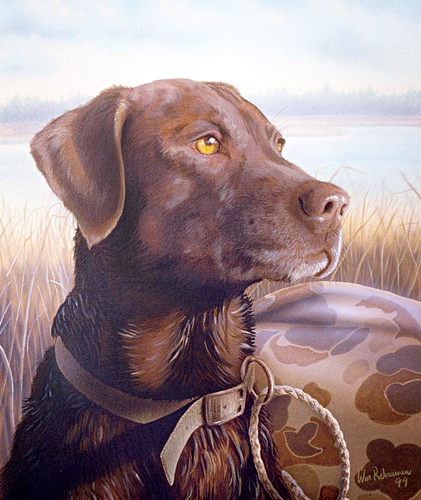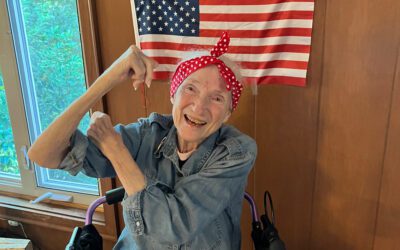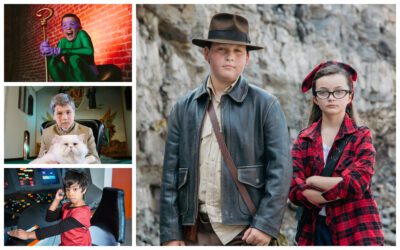[title subtitle=”story Marla Cantrell
images courtesy Bill Rebsamen”][/title]
Leaves are whipping across the street just outside Bill Rebsamen’s Fort Smith, Arkansas home. In the days to come a foot of snow will fall, it will stall the city, but today there is only this persistent wind. Inside, Bill works in his studio, a painting of turkeys coming to life. Bill leans over his drawing board, pointing to the line of trees that seems to go on forever. There is a process to making the trees diminish into the background, a process to the depth and light and life in this painting. He uses gouache (opaque water color) to get the tight detail he wants, sometimes even using it to airbrush certain parts of a painting to get the soft focus he needs.
Bill takes a break, reaches down, pats his long-haired dachshund, Teensie. She wags her tail, she pushes closer against Bill, her body all but shaking from happiness. “She’s a good girl,” Bill says, “an ornery girl,” he adds, and Teensie’s tail wags a little faster. “My wife and I have two other dachshunds, Dapper Dan, and D.J. (Dapper Dan Junior). Then we have three cats: Benny, Teddy, and an American Bobtail named Minnie. We love them all,” Bill says, and then laughs. “How could you not?”
He thumbs through his portfolio, which shows an extensive collection of pet portraits. He points to one of a Yorkie. “I just finished this one,” he says, “for one of my friends who wanted to give it to his wife for her birthday.” And then he tells the story of the dog that is thirteen, and defied fate this past summer when she fell from a boat, slipped into the lake without a sound, and was rescued by another boater who just happened to spot her, the little dog’s nose just above the waterline. Her owners were frantic when they realized she was missing, zipping back across the water, calling out her name, and finally pulling into the nearby marina where they found their dog, wet but happy, in the gift shop. The Yorkie now wears a life vest anytime she’s near the water.
Bill describes the search, the terror of losing your dog, your constant companion for well over a decade. “Can you imagine?” he asks, and shakes his head. The birthday gift was a big hit, and his friend called to tell him so. “He said he was Husband of the Year now,” Bill says, and smiles. “That’s like getting another payment. It’s one of the best parts of painting, knowing that your work is appreciated.” He estimates he’s done more than 100 pet portraits during his career. He typically shoots video of the pet to work from, so he can see them in action, get a feel for their personality, get to know them a little better. Often, though, he’s commissioned to paint portraits of pets that have passed away. When that happens he works from photos and asks a lot of questions of the owners.
In Bill’s studio, his work is everywhere. He’s studied wildlife for years, and has an affinity for big cats. He points to the painting of a tiger, this one with blue fur on its face, and it is so lifelike it appears to watch from its spot on the wall. “That tiger was seen by a Methodist missionary in the Fijian province of China. Henry Caldwell, who’d been over there a long time, was out gathering firewood. He had a rifle with him. He saw what he thought was a villager in a blue jacket and then he realized, once it moved, that it was a blue tiger stalking others who were farther down the hill, also gathering firewood. He didn’t have a clean shot, because of the people. He found a fur sample, though, and wrote a book about it. It’s a genetic anomaly, something that interests me a great deal.”
In another piece a spotted tiger takes center stage. A tiger that has spots where its stripes should be is another rarity, and Bill loves the extraordinary. His wildlife art has been published in several books written by British Zoologist Karl P.N. Shuker. Bill’s also had his art published by the Fortean Picture Library (an image broker) and several of those images were subsequently used by various Discovery channels like Animal Planet, Sy Fy and TLC.
But long before that, back when he was still a boy growing up in Fort Smith, he spent much of his time drawing and painting. He and his sister drew together, and his cousins and aunt are artists. His mother encouraged him. There were art teachers, both in school and in private lessons. And when he was a teen he studied with Susan Morrison, the renowned wildlife artist from Eureka Springs. “She was a stickler about animal anatomy and taught me so much,” Bill says. But it was Bill’s brother who garners much of the credit for his life in art. “He was in pre-med and had a zoology book and I basically re-illustrated it. If there was a dinosaur on the page, I re-drew it, right on the page. I’ve been a dinosaur nerd forever, and I love the animals we don’t see very often, and the sea creatures. I’ve read about them all.”
When Bill graduated from Southside, he’d already earned thirty credit hours from Westark Community College. “My mom was a staff nurse there,” he says, “and I took classes all through high school. I headed to Kansas City Art Institute and earned my degree in three years. I studied under lithography printmaking professor William McKim, who had studied under famed Missouri artist Thomas Hart Benton. McKim taught me to take artistic license and push tonality to the limits to make objects turn in space on a two dimensional surface. I learned to manipulate the image and place the darkest darks against the lightest lights between my subject and the background, a theme that’s seen in my work to this day.”
Once Bill was back in Fort Smith, he worked a few jobs, finally becoming a graphic artist for Weldon, Williams & Lick, a printing company that’s been around since 1898. In the late 1980s, he started doing paintings of hunting dogs to auction at the Ducks Unlimited banquets. “I had the grandiose idea of doing all these portraits of regal water dogs pictured in classic hunting scenes,” Bill says and then laughs. “But after the banquets I would get calls, not from the sportsmen, but from the hunters’ wives wanting me to do portraits of their Pomeranians, poodles and pussycats.”
And so he did, painting portraits that hang in homes across the region. The challenge is the same. You want the pets to come alive, and Bill does that, using techniques he learned over the years. He understands how important these pieces are, how much they mean to those who love their pets. “Animals have a quality, a personality and a soul. They’re an extension of your life,” he says. And then he tells his story, one of sorrow and redemption and the importance pets play in our lives. “We had a tragedy in our own family,” he says. “Our son Aaron was fourteen when he passed away. That was in 2002. At the time we didn’t have a single dog. I got my daughter a dog. She was twelve. We got her a Blue Merle Sheltie named Rufus, and it helped her tremendously. Of course, we were all dealing with grief differently. By the end of the next year, my wife and I had our own dachshunds. Dogs are God’s clowns that he put here on earth for us to enjoy. After the death of our son, Aaron, the first time I heard my wife laugh out loud, with a big smile on her face, was while she was playing with the dogs.”
It is as if Teensie has sensed a somber shift in Bill, sitting beside him on the couch. She raises her head, reaches out with her paw and places it on his leg. He reaches out and strokes her dark head, and she closes her eyes. The question of whether dogs go to heaven arises, and Bill says, “I don’t know if I’d go that far,” and then he pauses, and finally he backtracks, and says, “Well, my little dog will. I do believe she will.”
[separator type=”thin”]
To see more of Bill’s work, visit rebsamenstudios.com.




